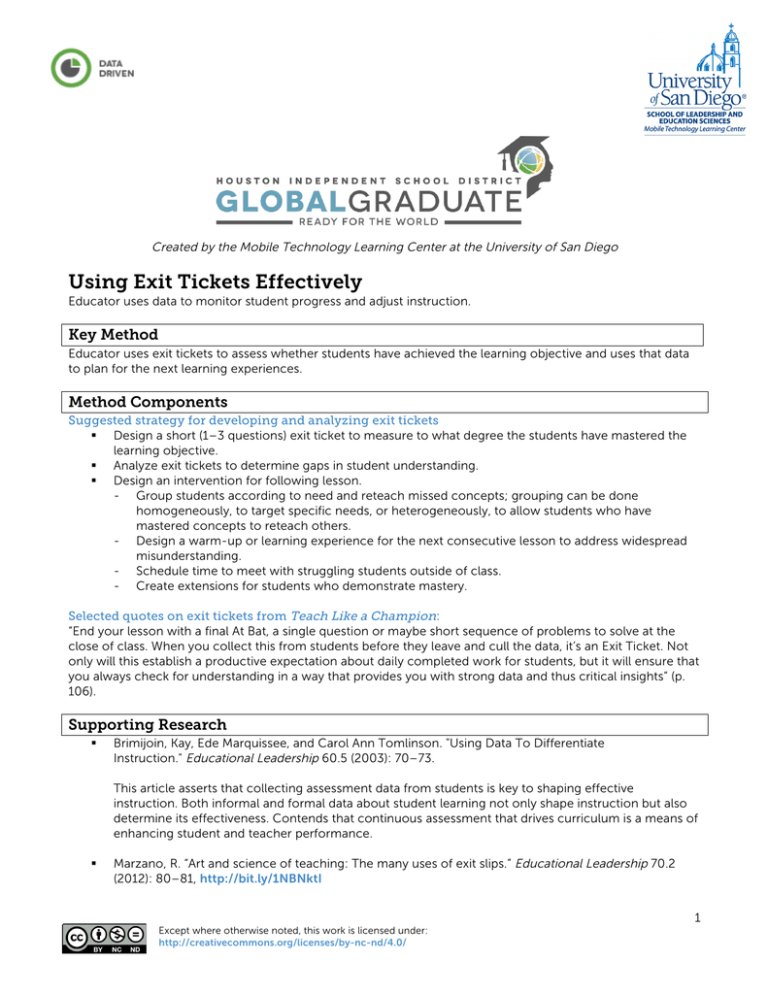Using Exit Tickets Effectively
advertisement

Created by the Mobile Technology Learning Center at the University of San Diego Using Exit Tickets Effectively Educator uses data to monitor student progress and adjust instruction. Key Method Educator uses exit tickets to assess whether students have achieved the learning objective and uses that data to plan for the next learning experiences. Method Components Suggested strategy for developing and analyzing exit tickets § Design a short (1–3 questions) exit ticket to measure to what degree the students have mastered the learning objective. § Analyze exit tickets to determine gaps in student understanding. § Design an intervention for following lesson. - Group students according to need and reteach missed concepts; grouping can be done homogeneously, to target specific needs, or heterogeneously, to allow students who have mastered concepts to reteach others. - Design a warm-up or learning experience for the next consecutive lesson to address widespread misunderstanding. - Schedule time to meet with struggling students outside of class. - Create extensions for students who demonstrate mastery. Selected quotes on exit tickets from Teach Like a Champion: “End your lesson with a final At Bat, a single question or maybe short sequence of problems to solve at the close of class. When you collect this from students before they leave and cull the data, it’s an Exit Ticket. Not only will this establish a productive expectation about daily completed work for students, but it will ensure that you always check for understanding in a way that provides you with strong data and thus critical insights” (p. 106). Supporting Research § Brimijoin, Kay, Ede Marquissee, and Carol Ann Tomlinson. "Using Data To Differentiate Instruction." Educational Leadership 60.5 (2003): 70–73. This article asserts that collecting assessment data from students is key to shaping effective instruction. Both informal and formal data about student learning not only shape instruction but also determine its effectiveness. Contends that continuous assessment that drives curriculum is a means of enhancing student and teacher performance. § Marzano, R. “Art and science of teaching: The many uses of exit slips.” Educational Leadership 70.2 (2012): 80–81, http://bit.ly/1NBNktI Except where otherwise noted, this work is licensed under: http://creativecommons.org/licenses/by-nc-nd/4.0/ 1 Effective lessons commonly end with an activity in which students reflect on their experience of the lesson. Over the last few years, exit slips have become a popular vehicle to this end. In its simplest form, an exit slip is an index card or piece of paper on which individual students respond to a prompt from the teacher. Resources § Example exit ticket templates, http://www.thecurriculumcorner.com/thecurriculumcorner456/exit-tickets/ § Assess and Plan with Exit Tickets, https://www.teachingchannel.org/videos/teacher-assessment-strategy The Teacher Toolkit: Exit Tickets, http://www.theteachertoolkit.com/index.php/tool/exit-ticket 5 Ways to Collect Digital Exit Tickets, http://bit.ly/1UTG23B Exitticket.org, http://exitticket.org/ Snapshots of Understanding? 10 Smart Tools for Digital Exit Slips, http://www.teachthought.com/technology/smart-tools-for-digital-exit-slips/ 33 Digital Tools for Advancing Formative Assessment in the Classroom, https://www.nwea.org/blog/2014/33-digital-tools-advancing-formative-assessment-classroom/ Creating a Digital Exit Ticket with Google Docs, https://www.youtube.com/watch?v=WB59ZUfA1ZI § § § § § § Submission Guidelines & Evaluation Criteria To earn this micro-credential, you must receive a passing evaluation for Parts 1 and 3 and an Exemplary score for Part 2. Part 1. Overview questions (300-word limit) § Please describe the specific learning experiences in which exit tickets were used. - Passing: Activity description is clear with sufficient detail to know what the educator did to adjust teaching based on the exit ticket. Part 2. Work examples/artifacts Submit artifacts/evidence (such as links to writing, audio, images, video, or other products) that were created while creating exit tickets and adjusting instruction based on the data they provided, including such items as: § Examples of different designs of exit tickets paired with the learning objective § Video of educator differentiating based on data from exit tickets § Students’ exit tickets and educator’s reflection on next steps Your artifact will be assessed on the following rubric. You must earn an Exemplary score on this portion of the submission in order to earn the micro-credential. Needs Improvement Developing Evidence demonstrates an attempt to use exit tickets, but the exit tickets do not align with the desired learning objective. Evidence demonstrates that the educator used exit tickets, but may not have measured a key component of the desired learning objective. Evidence demonstrates the educator’s ability to effectively create and administer exit tickets that capture whether or not the student achieved the desired learning objective. Evidence suggests educator does not effectively adjust future lessons based on exit tickets. Evidence suggests educator adjusts consecutive lessons but may not reach every student. Evidence suggests the educator uses exit tickets to seamlessly adjust consecutive lessons that Except where otherwise noted, this work is licensed under: http://creativecommons.org/licenses/by-nc-nd/4.0/ Exemplary 2 meet every student at his or her level. Part 3. Reflection Provide a reflection on what you learned using the following questions as guidance (300-word limit): § What did you learn through the process of integrating exit tickets into your learning experiences? Moving forward, how might your teaching practices change? - Passing: Educator describes what he or she learned and how implementing exit tickets will change his or her future practice. Except where otherwise noted, this work is licensed under: http://creativecommons.org/licenses/by-nc-nd/4.0/ 3
